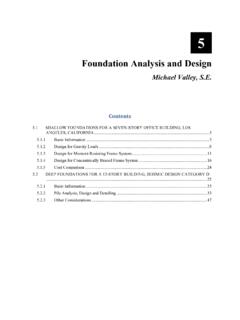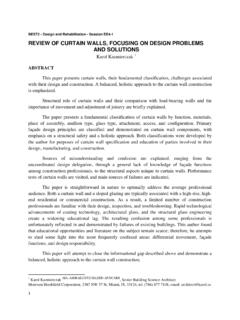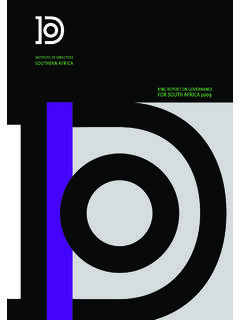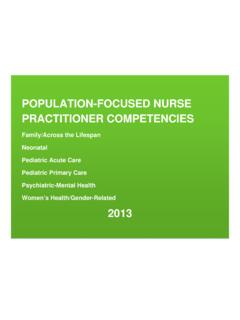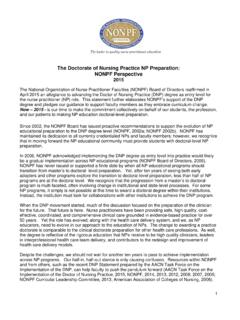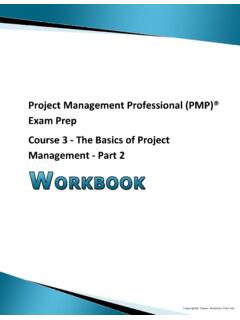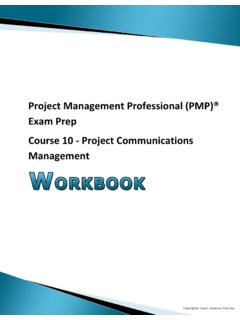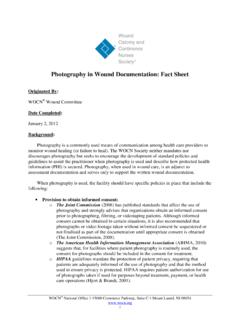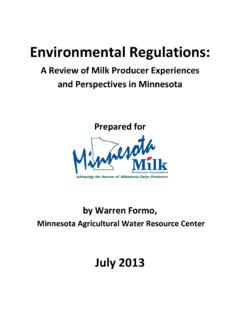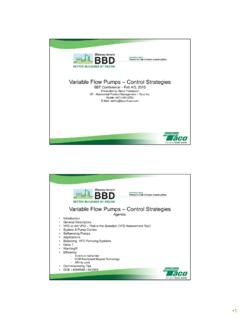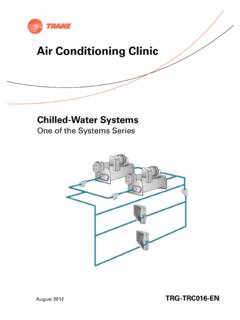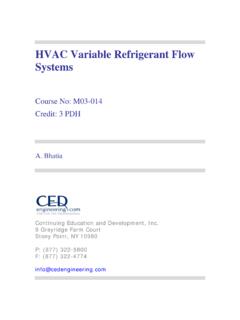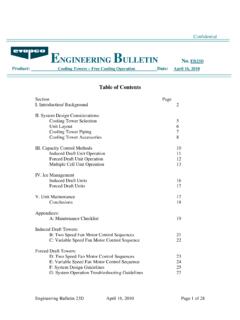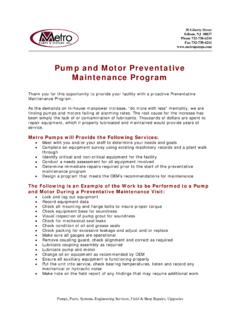Transcription of Code of Practice Flows and Loads – 4
1 Code of PracticeFlows and Loads 4 Sizing Criteria, Treatment Capacity for Sewage Treatment SystemsSouthbank HouseBlack Prince Road London SE1 COP: ISBN 978-1-903481-10-31 ScopeThe purpose of this code of Practice is to provide an appropriate table of loadings (volumes and Loads ) to allow the total daily load entering a treatment system to be RegulationsEarly contact with the Regulator to discuss the proposed discharge of sewage effluent is advisable. Planning requirements, eg DETR Circular 3/99, site survey, etc. Building regulations, eg part H DTLR England & Wales, part M Scotland, Water (Northern Ireland) Order 1999 and Northern Ireland building regulations. A Permit, Authorisation or Consent to discharge will be requiredfrom the environmental regulators (the Agencies). Planning permission (Local Authority Planning Guidance).3 Definitions of terms Population (P) number of people the system will serve. Biochemical oxygen demand (BOD5) Mass concentration ofdissolved oxygen consumed under specified conditions (5 days at 20 C with nitrification inhibition) by the biological oxidation oforganic and/or inorganic matter in water.
2 Ammonia expressed as mg/l N Ammonia is NH3, Ammonium is NH4OH. In wastewater we frequently refer to and use the word/symbol, ammonia/NH3. The term ammonia usually includesammonium as Selection considerations all applications Values and conditions required by any regulatory permit or consent. Loading figures for each specified load are given for Flow, BODand NH3. The user/purchaser of the system must declare ALL ACTIVITIESto enable all Loads entering the treatment system to be identified and evaluated. The user/purchaser should be made aware that there is a risk of poor performance from the equipment if Loads are understated. The accuracy of the declared Loads is of paramount importance. Guidance points given under each category suggest questionsto enable the specifier to recognise variable or unusual Loads ,particular to that site, to improve correct system selection and design. Total daily loadings are calculated based on the anticipated final maximum capacity of the site.
3 New sites initially may have a reduced business level but the system suggested should reflect the full business potential, a system suggested for a hotel or caravan site or any other application, with an average 80%occupancy rate should be designed to handle 100% occupancy. The equipment selected by the specifier should reflect themaximum potential of the site. Where a specifier is instructed to use lower occupancy rates, this should be recorded. Flow balancing should be considered where appropriate Excess disinfectants, chemicals, etc can affect the biological processes as can specific toxic substances from site activities photographic chemicals, weed killers, motor oils. It is assumed that these substances are excluded from the wastes to be treated. Some water treatment equipment effluents eg softeners,chlorinated backwashes may not be acceptable; system designers should specifically accept or exclude their use. Many treatment system designs will accept regenerants into their units, however this must be checked and agreed.
4 Water saving devices affect sewage strength, the impact of their installation should be identified. Laundries affect sewage strength and treatability; their proportionshould be identified. Surface/storm water is not permitted as part of the wastewaterstream and must be excluded. It is assumed, unless stated, that waste disposal units (WDU) are not in use. Undersizing of equipment is to be avoided as it is always better to have a plant slightly oversized, rather than on the limit or of PracticeFlows and Loads Sizing Criteria, Treatment Capacity for Sewage Treatment SystemsThis code of Practice was prepared by the British Water Package Sewage Treatment Plant Focus Group comprising manufacturers, suppliers and service companies of all types of small wastewater treatment Environment Agency, the Northern Ireland Environment Agency and the Scottish Environment Protection Agency support the use of this code of Practice .
5 But the Agencies do not specifically endorse any particular manufacturer s code of Practice provides a table of loadings which allows the total daily sewage load from properties to be calculated and it is recommended that all designers should use this table when sizing and designing non-mains sewage treatment systems. The Flows and Loads values given represent current best knowledge within the UK but may change with time in line with per capita water use. Where proposed alternative usage rates or methods of sizing might be more appropriate for a particular application this should be supported by the collection of data or additional site specific evidence to validate the proposal. Professional judgment is required and may be used to compare alternatives especially when assessing sewage strengths and is provided to assist the user to identify the various sources of sewage, to consider the nature of the sewage to be treated and to make users aware of issues which may affect treatability and system performance.
6 Each manufacturer is aware of the capabilities of their own systems with respect to different table of loadings may be used to design all sizes of sewage treatment systems serving up to 1000 of this code of Practice by all UK manufacturers and system designers will: help to clearly define site activity and sewage sources promote a consistent approach to collecting accurate andcomplete loading information provide consistent information about problem effluents and treatability, and promote the design and installation of appropriatetreatment systems and so reduce the problem ofundersized systems causing environmental loadings in this code of Practice are more comprehensive than in previously published guidance, they are generally higher and include values for (continued on page 4) JThe owner of the treatment system holds the permit, consent or authorisation to discharge and should be aware that he is responsible for the effluent quality discharged.
7 Thus all sources of discharge into the system must be declared. It is an offence if the effluent fails to comply with the regulators of Loadings for Sewage Treatment SystemsPer person / activity / day (unless otherwise specified) FLOW BOD Ammonia as NDOMESTIC DWELLINGS(Litres)(Grams)(Grams) Standard residential 150 60 8 Mobile home type caravans with full services 150 60 8 INDUSTRIALO ffice / Factory without canteen 50 25 5 Office / Factory with canteen 100 38 5 Open industrial site, construction, quarry, without canteen 60 25 5*Full-time Day Staff90 38 5*Part-time Staff (4 hr shift)45 25 3 SCHOOLSNon-residential with canteen cooking on site 90 38 5 Non-residential without a canteen 50 25 5 Boarding school (i) residents 175 60 8(ii) day staff (inc. mid-day meal)90 38 5 HOTELS, PUBS & CLUBSH otel Guests (Prestige hotels) 300 105 12 Hotel Guests (3H & 4H hotels) 250 94 10 Guests (Bedroom only no meals) 80 50 6 Residential Training/Conference Guest (inclusive all meals) 350 150 15 Non residential Conference Guest 60 25 camp chalet resident 150 94 10 Resident Staff 180 75 10 Restaurants - Full Meals - luxury catering 30 38 4- pre-prepared catering25 30 Snack Bars & bar meals15 19 Function Rooms including buffets15 19 Fast Food (roadside restaurants)12 12 Fast Food Meal (burger chain and similar)12 15 4 Students (Accommodation only) 100 60 8 AMENITY SITEST oilet Blocks (per use) 10 12 (WC) (per use) 10 12 (Urinal) (per use) 5 12 Blocks in long stay car parks/lorry parks (per use) 10 19 4 Shower (per use)
8 40 19 2 Golf Club 20 19 5 Local community sports club, squash, rugby & football 40 25 6 Swimming (where a separate pool exists without an associated sports centre) 10 12 Club/Sports Centre 50 19 4 Tent sites 75 44 8 Caravan Sites - (i) Touring not serviced 100 44 8(ii) Static not serviced100 44 8(iii) Static fully serviced150 60 8 HOSPITALS & RESIDENTIAL CARE HOMESR esidential old people / nursing 350 110 13 Small hospitals 450 140 AssessLarge hospitals Assess individually*Staff figures also apply to other applications35 Domestic housing A treatment system for a single house with up to and including 3 bedrooms shall be designed for a minimum population (P) of 5 people. The size of a treatment system for a single house with more than 3 bedrooms shall be designed by adding 1 P for each additional bedroom to the minimum single house value of 5 P, eg:- house with 3 bedrooms = minimum 5 P system- house with 4 bedrooms = minimum 6 P system (5+1)- house with 6 bedrooms = minimum 8 P system (5+3).
9 For groups of small 1 and 2 bedroom houses or flats - flat with 1 bedroom = allow 3 P - flat with 2 bedrooms = allow 4 P A treatment system serving a group of houses shall be designed by adding together the P values for each house calculated independently, eg:- for a group of two houses (3 and 4 bedrooms, respectively) the system shall be for a minimum of 11 P (5+6) If the calculated total P for a group of houses exceeds 12 P then some reduction may be made to allow for the balancing effects on daily flow of a group of houses (round UP not down)- Where the total is 13-25 P multiply the total by to give an adjusted P value, if there are four four-bedroom houses the total P will be 24 P (4 x 6) and the adjusted P will be 22 P (24 x = )- Where the total is 26-50 P multiply the total by to give an adjusted P value, if there are four three-bedroom houses and three four-bedroom houses the total P will be 38 P (4 x 5 and 3 x 6) and the adjusted P will be 31 P (38 x = ) Where there are larger groups of houses, the P should be estimated using both the expected total load and the flow, considering both peak and total flow These are minimum recommended population (P)
10 Loads , they should not be modified downwards, upward modification may be necessary because of particular characteristics of each property or groups of properties. The above assessments of population (P) should be used for both existing and new properties6 Commercial Premises Identify ALL the sources of waste. Identify final maximum site usage/business expectations. The individual values provided for each function within the table assume that 100% of every application and load is quantified. DO NOT reduce values based on reduced expectations. All catering applications require the installation of adequately sized grease separators, removal or retention systems up-stream of the biological treatment Catering premises Establish maximum (and minimum) daily load based on a 24 hour cycle. Check period of operation. Identify dates of maximum Loads , Mothering Sunday, Easter, Bank holidays, Fridays etc.
